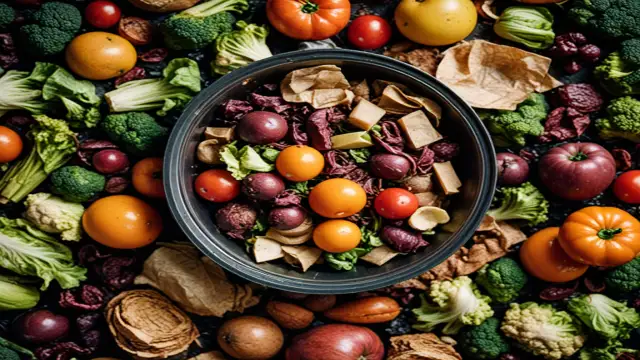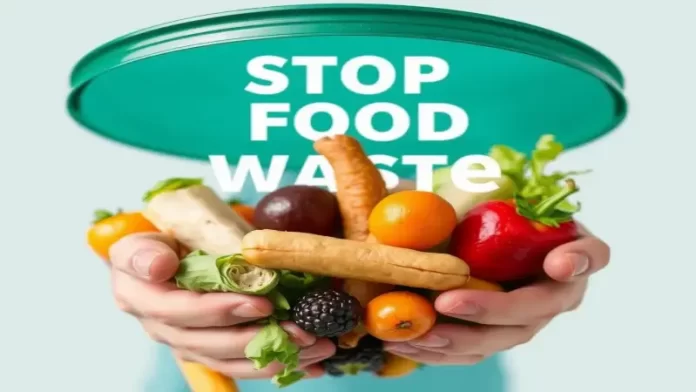Table of Contents
Let’s Talk Trash: Getting Real About Reducing Food Waste
Ever opened your fridge, peered into the crisper drawer, and found something… science-projecty lurking in the back? Yeah, me too. Its that forgotten bunch of cilantro, the slightly-too-squishy tomatoes, the leftover takeaway that seemed like a good idea three nights ago. We sigh, maybe feel a pang of guilt, and then? We chuck it. Out of sight, out of mind.
But here’s the thing: all that discarded food adds up. Like, really adds up. Globally, it’s estimated that around a third of all food produced for human consumption gets lost or wasted. Let that sink in. A third. That’s not just a waste of potential meals; it’s a staggering waste of the water, energy, land, and labor that went into growing, processing, and transporting it. And guess what? It has a massive environmental footprint too. Tackling food loss and waste isn’t just about saving a few bucks on groceries (though that’s nice!); it’s a crucial piece of the puzzle for a healthier planet.
So, how do we actually stop food waste? Turns out, there are loads of solutions to food waste, starting right in our own kitchens and extending all the way up the supply chain.

Your Kitchen Counter: The Front Line in the War on Waste
Ok, let’s get down to the nitty-gritty. Learning how to reduce food waste at home is probably the most impactful place for most of us to start. Its where we have the most control, and small changes genuinely make a difference. Forget drastic overhauls; let’s talk practical food waste tips:
- Become a Planning Pro (or Just Wing It Less): Honestly, how often do you go to the store without a list, grab what looks good, and end up with way too much? Thought so.
- Meal Plan: Doesn’t have to be fancy. Just jot down rough ideas for meals for the next few days.
- Shop Your Fridge First: Before you even think about a list, look at what you already have. What needs using up pronto? Plan meals around that.
- Stick to the List (Mostly): Those BOGO deals are tempting, but if you won’t realistically use two giant bags of spinach before they turn slimy, is it really a deal? Be honest with yourself.
- Storage Smarts – Give Your Food a Fighting Chance: You wouldn’t leave ice cream on the counter, right? Different foods need different conditions.
- Fridge Feng Shui: Learn where things belong. Keep veggies happy in the crisper, milk and leftovers where it’s coldest (not the door!).
- Airtight Containers are Your Friends: Especially for leftovers. They keep things fresh longer and prevent weird fridge smells. Transparency helps – if you can see it, you might remember to eat it.
- FIFO Love: First-In, First-Out. When you buy new groceries, move the older stuff to the front. Simple, but effective.
- Understand Dates: “Best before” is about quality, not safety. “Use by” is the one to pay closer attention to for safety. Use your senses – look, smell, maybe a tiny taste (if appropriate). Lots of food is perfectly fine past its “best before” date. There’s less excuses now for chucking perfectly good yoghurt.
- Embrace the Leftover Lifestyle: Leftovers ain’t a punishment; they’re ingredients for tomorrow’s creativity!
- Reimagine, Don’t Reheat (Always): That leftover roast chicken? Slice it for sandwiches, shred it for tacos, toss it in a salad, make soup. Endless possibilities!
- Planned Leftovers: Cook extra rice or pasta intentionally. It’s half the work done for tomorrow’s lunch.
- “Use It Up” Bin: Have a designated spot in the fridge for things that need eating now. Check it daily.
- Get Scrappy – Use the Whole Dang Thing: We’re often conditioned to throw away perfectly edible parts of plants and animals. Time to rethink!
- Stems & Leaves: Broccoli stems? Slice ’em thin and stir-fry ’em! Carrot tops? Pesto! Celery leaves? Flavour enhancer!
- Peels (Sometimes): Potato peels (scrubbed well) make amazing crispy snacks when baked or fried. Just sayin’.
- Bones & Veggie Scraps: Keep a bag in the freezer for veggie odds and ends (onion skins, carrot peels, celery butts) and chicken carcasses. Simmer them up for amazing homemade stock. Way better (and cheaper) than store-bought. These are some creative ways to reduce food waste that also boost flavour.
- Portion Power: Cook and serve realistic amounts. It’s always better to go back for seconds than to scrape excess food into the bin.
- Compost Like a Champ: For the scraps you genuinely can’t use (egg shells, coffee grounds, banana peels), composting is brilliant. It turns waste into nutrient-rich fertilizer for your garden or houseplants. If you don’t have space, check for local community composting programs. It’s a core food waste reduction strategy at the household level.
Implementing even a few of these food waste tips consistently will drastically reduce food waste at home.
Tackling Food Waste in Restaurants
Okay, home kitchens are one thing. But what about eating out? Food waste in restaurants is a whole different beast, involving prep waste, spoilage, and uneaten customer meals. The scale is often much larger. However, there are definite ways to reduce food waste in restaurants:
- Smarter Menus & Prep: Designing menus where ingredients overlap, using precise prep techniques to minimize offcuts, and better staff training on handling food efficiently.
- Inventory Vigilance: Robust tracking systems mean ordering smarter and using stock before it expires. Technology help here, like specialized software.
- Portion Options: Offering half-portions or different size choices empowers customers to order what they can actually finish.
- Donation Partnerships: Connecting with local charities or food banks to donate surplus edible food is a fantastic solution to food waste that also addresses food insecurity. Laws protecting businesses that donate food are crucial here.
- Embracing “Ugly”: Being less fussy about cosmetically imperfect produce from suppliers can prevent perfectly good food from being rejected further up the chain.
- Tech Assists: Some innovative restaurants utilize food waste reduction apps that allow them to sell surplus meals at a discount towards the end of the service, ensuring food gets eaten instead of binned.
It requires commitment from management and staff, but the potential savings (both financial and environmental) are huge. Everyone need to be onboard for it to work.
Food Loss and Waste Across the Chain
It’s important to distinguish between food loss and food waste. Generally:
- Food Loss: Happens before food reaches the consumer. Think crops lost during harvest, spoilage during transport or storage, issues in processing. This is often a bigger problem in developing countries due to lack of infrastructure (like reliable cold storage).
- Food Waste: Happens at the retail and consumer level (supermarkets, restaurants, our homes). This tends to be a bigger issue in developed countries.
Addressing food loss and waste in the food supply chain requires big-picture thinking and food waste reduction strategies:
- Infrastructure Investment: Better roads, reliable cold chains, improved storage facilities, especially in developing nations.
- Rethinking Cosmetic Standards: Why does a carrot need to be perfectly straight? Challenging overly strict retailer standards for appearance can save tons of perfectly edible produce.
- Improved Processing & Packaging: Techniques that extend shelf life naturally or packaging that genuinely reduces spoilage (though we need to balance this with packaging waste concerns).
- Policy & Education: Standardizing date labeling, promoting food recovery hierarchies (feed people first, then animals, then compost/energy), and widespread consumer education campaigns are key ways to reduce food waste globally.
Can Tech and Business Save Us from Ourselves?
Innovation is playing a increasingly important role. We’re seeing a rise in food waste reduction companies and clever apps:
- Surplus Food Marketplaces: Apps like Too Good To Go (globally) or local equivalents connect consumers with restaurants and cafes selling off unsold food at reduced prices. It’s a win-win-win: consumers get cheap eats, businesses recoup some cost, and food isn’t wasted. The food waste reduction app space is buzzing.
- Upcycling Innovators: Companies that reduce food waste by taking surplus or byproduct ingredients and turning them into new, valuable products. Think drinks made from leftover whey, snacks made from imperfect fruit, or flours made from spent grain from breweries.
- Supply Chain Analytics: Tech companies providing sophisticated tracking and predictive analytics to help producers, distributors, and retailers manage inventory more effectively and predict demand, thus reducing spoilage.
- Spoilage Detection: Development of sensors and smart packaging that can more accurately indicate food freshness, moving beyond arbitrary date labels.
These food waste reduction companies are proving that sustainability can also be good business.
Reduced Food Waste = Climate Action
Why all this fuss? Beyond the ethical and economic arguments, reduced food waste has a direct impact on climate change.
When food ends up in landfill, it decomposes anaerobically (without oxygen) and releases methane (CH4). Methane is a potent greenhouse gas, way more effective at trapping heat in the short term than carbon dioxide (CO2). Landfills are a major source of human-caused methane emissions.
Plus, think of all the embedded emissions in wasted food: the CO2 from tractors planting the seeds, the energy used for irrigation pumps, processing plants, refrigerated trucks, supermarket lighting… all for food that never even gets eaten. It’s a massive, unnecessary burden on our planet’s resources. Reducing food waste isn’t just nice to do; it’s a powerful and relatively accessible way for individuals, businesses, and governments to contribute to climate change mitigation. The data show the connection is undeniable.
Let’s Stop Talking Trash and Start Taking Action
So, yeah, food waste is a big, complex problem. It spans from our fridge habits to global logistics, food waste in restaurants to farming practices. But the good news? There are solutions at every level.
We don’t all need to become zero-waste gurus overnight. But we can all do something. Pick one or two food waste tips from the list above and really commit to them this week. Plan one extra meal around leftovers. Try composting for the first time. Be a bit more mindful during your next grocery shop.
Learning how to reduce food waste at home is empowering. Supporting businesses with strong food waste reduction strategies sends a message. Understanding the link between food loss and waste and climate change motivates us. Together, these actions ripple outwards. Let’s get our act together and stop food waste for our wallets, for people, and for the planet. Sound like a plan?

